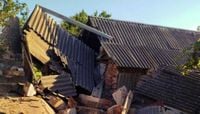On the morning of September 16, 2025, the city of Kharkiv—Ukraine’s second-largest metropolis and a mere 30 kilometers from the Russian border—was rocked by a series of Russian drone attacks that left destruction, injuries, and a shaken community in their wake. The most dramatic of these incidents occurred when a Russian drone slammed into the roof of an administrative building belonging to a pharmaceutical educational institution in Kharkiv’s Slobodskyi district, sending a plume of smoke skyward and scattering debris across the surrounding streets.
According to Suspilne, the targeted building was not a military installation, but rather a civilian training unit associated with a university. Oleh Syniehubov, the governor of Kharkiv region, emphasized this point, stating, “This building housed a training unit. This facility had no connection to the defense or military industry. This is an exclusively civilian building.” The attack, which took place around 11 a.m. local time, caused a fire that engulfed 150 square meters (1,615 square feet) of the building, as reported by Ukraine’s State Emergency Service.
Firefighters, psychologists, and other emergency responders rushed to the scene to extinguish the blaze and tend to the victims. Kharkiv Mayor Ihor Terekhov reported that at least four people had been injured by 1 p.m. that day. The staff inside the building, fortunately, managed to seek shelter before the impact and avoided physical harm, though the psychological toll was evident. University worker Nataliia Lavrova recounted her harrowing experience to Reuters: “I heard the sound (of the drone) right over my head. I was sitting at my computer, and my intuition told me to get up, I literally made two steps, and then the chandelier fell. There was an explosion, and the chandelier under which I had just sat fell down. That's what happened.” One woman was treated for psychological trauma after witnessing the strike, highlighting the invisible scars left by such attacks.
Oleksandr Kukhtenko, the vice-rector for scientific and pedagogical work at the university, described the extent of the damage to Suspilne: “The roof, the offices of the employees, the head of the department, and associate professors were very badly damaged. The situation with the fire: The guys were putting it out, the building was flooded. There will be a lot of questions about the restoration of the building.” Restoration is expected to be a lengthy and challenging process, given the scale of destruction and the ongoing threat of further attacks.
The attack on the university was not an isolated incident. Across Kharkiv Oblast, Russian FPV (first-person view) drones struck multiple locations on September 16, causing further injuries and widespread destruction. According to Ukrainska Pravda and Ukrinform, at around 10:00 a.m., a 63-year-old man was injured by a blast in the city of Kupiansk. Just an hour later, at approximately 11:00 a.m., an 82-year-old man was wounded in the village of Osynove, also in the Kupiansk district. The Kharkiv Oblast Prosecutor’s Office confirmed these attacks and detailed additional strikes on the Zolochiv hromada in the Bohodukhiv district, where a house was destroyed in the village of Lemishchyne and several homes, outbuildings, and a disused outpatient clinic were damaged in the village of Tymofiivka.
These assaults have had a profound effect on the local population, many of whom have already endured years of conflict and uncertainty. The psychological impact is compounded by the unpredictability and frequency of the attacks. University staff and residents alike are forced to remain vigilant, seeking shelter at the first sign of danger. The involvement of psychologists in the emergency response underscores the growing need for mental health support in communities repeatedly targeted by drone and missile strikes.
Authorities have responded by launching pre-trial investigations into the attacks, treating them as potential war crimes under Part 1 of Article 438 of the Criminal Code of Ukraine. The Kharkiv region prosecutor’s offices, guided by the Kupiansk and Bohodukhiv district prosecutor’s offices, are leading these probes. The legal response is part of a broader effort to document and address the mounting toll of civilian harm in the region.
The broader context of these attacks is sobering. According to Ukrainian President Volodymyr Zelenskiy, Russia has launched more than 3,500 drones of various types, nearly 190 missiles, and over 2,500 aerial bombs in Ukraine so far in September 2025 alone. This relentless barrage has left a trail of devastation across the country, with Kharkiv and its surrounding oblast bearing a significant share of the burden. Over the course of just one day, Russian strikes hit 12 settlements in the Kharkiv region, resulting in one death and five injuries, as reported by Ukrinform.
The repeated targeting of civilian infrastructure, residential buildings, and educational institutions has drawn condemnation from Ukrainian officials and international observers. The destruction of a university building in Kharkiv is emblematic of a broader pattern of attacks that disrupt daily life, impede access to education, and undermine the social fabric of affected communities. The damage to homes, outbuildings, and even a disused clinic in Bohodukhiv district further illustrates the indiscriminate nature of the violence.
For many in Kharkiv, the events of September 16 are a grim reminder of the precariousness of life near the front lines. The city’s proximity to the Russian border makes it a frequent target, and the resilience of its residents is tested daily. Yet, amid the destruction, there are stories of survival and quick thinking—like that of Nataliia Lavrova, who narrowly escaped injury thanks to a split-second decision. The rapid response of emergency services and the solidarity of the community offer a measure of hope, even as the challenges of recovery and restoration loom large.
As Kharkiv and its surrounding oblast continue to grapple with the aftermath of these attacks, the need for international attention and support remains urgent. The documentation of war crimes, the provision of humanitarian aid, and the commitment to rebuilding civilian infrastructure will all be crucial in the months ahead. For now, the scars of September 16 serve as a stark testament to the enduring human cost of the conflict.





